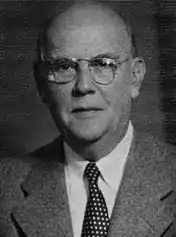Hüseyin Cahit Yalçın
Hüseyin Cahit Yalçın (7 December 1874, in Balıkesir, Ottoman Empire – 18 October 1957, in Istanbul, Turkey) was a prominent Turkish theorist, writer and politician. He is famous for being a dissident journalist, who has been put on trial and punished due to his columns. His publications defending the idea of a homogenous nation became popular within the Party of Union and Progress.[1]
Hüseyin Cahit Yalçın | |
|---|---|
 | |
| Member of the Grand National Assembly | |
| Personal details | |
| Born | 7 December 1874 Balıkesir, Ottoman Empire |
| Died | 18 October 1957 Istanbul, Turkey |
| Nationality | Turkish |
| Political party | Party of Union and Progress, Republican People's Party |
Biography
Hüseyin Cahit was born in 1874 in Balıkesir. He started his literary life by writing stories, novels and prose poems. He later wrote on journalism, criticism and translation. He also wrote satirical poems under the pseudonym Hemrah. He is one of the most important figures of the Edebiyat-ı Cedide (New Literary Movement). After the Second Constitutional Era, he helped Tevfik Fikret and Hüseyin Kazım to publish the Tanin newspaper, as it was put into political life. By the time he started his political career and joined the Union and Progress Party. He was selected to Ottoman Parliament (Meclis-i Mebusan) in 1908 and served until 1912. Between 1908 and 1911, he wrote for the newspaper Tanin, in which he opposed a German influence on the Ottoman Empire.[2]
He escaped to Romania during 31 March Incident since rebels had decided to kill him but they murdered Mehmet Aslan Bey instead.[3] After the suppression of the riots, he returned to Istanbul.
In 1911, he started working at Ottoman Public Debt Administration. However, he had to leave Istanbul again in 1912 and moved to Wien as his journal Tanin was closed due to his opposing views. He came back to Istanbul only after 1913 Ottoman coup d'état. Even though he was opposed German influence in the past, he joined the German-Turkish association which would support the cultural and economic exchange between the two empires in 1915.[4]
After the First World War, Huseyin Cahit was exiled to Malta and stayed there until 1922. Right after his return he started a newspaper called Renin but after a while renamed it as Tanin. He supported Mustafa Kemal and Turkish Independence War in his articles. However, he contradicted Ankara Government soon due to abolition of sultanate and the caliphate.[5]
During Ataturk era (1923-1938) Huseyin Cahit kept his position as an opposition journalist and criticized many policies of the Government, including the revolutions such as abolition of caliphate and language reform. Huseyin Cahit promoted liberal democracy and blamed Ankara Government for imposing a tight control over society and culture. However, his criticisms were perceived suspiciously due to his background with the Union and Progress Party.[6] He was put on trial by Independence Court for 3 times, he was acquitted twice but in 1925 he was exiled to Çorum.[7] In 1926 banishment was forgiven and he returned to Istanbul.
After Ataturk's death, Huseyin Cahit was invited to CHP by Ismet Inonu and he was elected to the Parliament.
He started publishing Tanin Newspaper again in 1943. He wrote articles against communism. In his article dated 3 December 1945, he directly blamed Tan Newspaper and Sabiha Sertel for supporting communism and the USSR. This article played an important role on proviking people and Tan Newspaper was assaulted.
In 1954, when he was jailed again for his article against Democrat Party. He was forgiven by the Head of Republic Celal Bayar since he was 79 years old at that time. In 1957, he was a candidate for Parliament elections but he passed away on 18 October 1957 before the results.[8]
Support for the Armenian Genocide
In 1936, Yalçın wrote an article arguing that Bahaeddin Şakir (who is generally considered to be the main architect of the Armenian Genocide) should be honored for his role in the persecution of Armenians.[9]
Notes
- Taner Akçam (2006). A Shameful Act. Henry Holt and Company. ISBN 9780805086652.
- Guillemarre-Acet, Dorothée (2009). Impérialisme et nationalisme: l'Allemagne, l'Empire ottoman et la Turquie (1908-1933) (in French). Dietrich, Dr. Hans-Jurgen, Ergon Verlag. pp. 37–39, 88. ISBN 978-3-89913-694-4.
- Cumhuriyet, Gazetesi (1 March 2012). "31 Mart'ın 103.Yılı". Cumhuriyet Gazetesi. Retrieved 20 October 2020.
- Guillemarre-Acet, Dorothée (2009), p.196–198
- Yalcin, Huseyin Cahit. "Huseyin Cahit Yalcin". Biyografi. Retrieved 20 October 2020.
- Yüksel, Nahit. ""FİKİR HAREKETLERİ" DERGİSİNDE (1933-1940) HÜSEYİN CAHİT'İN (YALÇIN) TÜRK DEVRİMİ'NE BAKIŞI" (PDF). Ataturk Arastirmaları Merkezi Dergisi.
- Gisela Procházka-Eisl, Die Lieder des Papageien, 2005, ISBN 9783825886479
- "Biografya: Hüseyin Cahit Yalçın". www.biyografya.com.
- Zürcher, Erik Jan (2011). "Renewal and Silence: Postwar Unionist and Kemalist Rhetoric on the Armenian Genocide". In Suny, Ronald Grigor; Göçek, Fatma Müge; Naimark, Norman M. (eds.). A Question of Genocide: Armenians and Turks at the End of the Ottoman Empire. Oxford University Press. pp. 315–316. ISBN 978-0-19-979276-4.